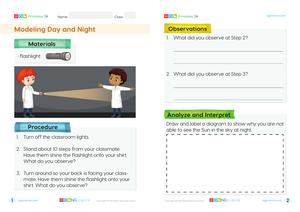Begin by asking students to look up at the night sky and describe what they see. Introduce the concept of stars as big balls of hot gas that are far away.
Go to the LessonLearning Objectives
- Identify stars as big balls of hot gas that are far away.
- Recognize that the Sun is a star and is the closest one to Earth.
- Understand the importance of the Sun's light and warmth for life on Earth.
- Describe how stars vary in size, color, and brightness.
Introduction and Hook
Discuss the Sun as the closest star to Earth and its importance for life, setting the stage for further exploration.
Direct Instruction
Explain the characteristics of stars, including their size, color, and brightness. Emphasize the Sun's role as a star.
Guided Exploration
Engage students with the video 'Movements of the Earth – Quiz Edition' to explore Earth's movements and their effects.
Facilitate a discussion on how stars and the Sun are observed differently during day and night.
Hands-On Activity
Conduct an activity where students classify objects or images as 'day' or 'night' based on the presence of the Sun or stars.
Independent Practice
Assign students to draw and label a diagram showing the Sun and stars, highlighting their understanding of size and distance.
Check for Understanding
Conduct a quick quiz to assess students' understanding of the Sun as a star and its importance to Earth.
Try the QuizReview and Reflection
Have students share their drawings and observations about stars and the Sun, discussing any new insights.
Reflect on the learning objectives and how they were met through the lesson activities.





